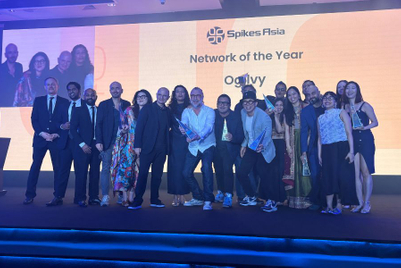
“We had no idea it would take off the way it did,” Clemenger BBDO planning director Matt Pearce said of the now iconic road safety effigy during a Thursday afternoon session at Spikes Asia 2017. Up until the night before launch, Graham creators were simply hoping someone would see it for what it was. “So much blood, sweat and tears went into it.”
'Meet Graham' is a strong contender here at Spikes, after garnering 29 Lions in Cannes in June (including two Grand Prix), then adding nine Tangrams effectiveness awards this week (including four gold).
Pearce explained that the brief from the Transport Accident Commission (TAC) of Victoria was to educate Victorians about their vulnerability to road trauma. For many years, TAC had taken a very one-dimensional ‘crash-die-cry’ approach to scaring drivers into not driving recklessly.
“Another shocking crash wouldn’t educate people.” Pearce said. “They were desensitised to it.” Instead, the creative team wanted a less judgmental message emphasising a shared vulnerability to road accidents for all drivers.
Where the idea came from
TAC had reams of data on road safety but Pearce said one data point continually stood out: how an average male was not designed to withstand the force of impact faster than 30 kilometres an hour.
So the team wondered aloud—what a man designed to withstand a crash would look like. They made an original rendering in statue form, named him Graham (a name that “just stuck” Pearce says, because it represented a familiar Aussie name, an everyday guy) and the client immediately green-lighted the plan to build a human-like sculpture.

During the Cannes festival this past June, a couple of juries questioned the originality of the idea, feeling it was too similar to an Ogilvy spot released more than 30 years ago that created a human form made to withstand the effects of smoking.
But Pearce told Campaign the creative team was not even aware of that ad, made before some of the team members had been born. Instead, he said, the inspiration came from that resurfacing data point.
The ‘average male’ part of that data point also stuck. Graham was a male sculpture for two reasons, Pearce said. Men were far more at risk of dying in a car crash on Victoria’s road statistically. Also, the aim was to make Graham grotesque to make drivers think about alternate solution to car crashes and change their behaviour. Pearce told Campaign it was more publically acceptable to build a repulsive man than a woman.
How Graham was made
BBDO wanted the public to have a visceral reaction to Graham, yet the creative team handed his formation over to the experts.
They brought in Christian Kenfield, a trauma surgeon from the Royal Melbourne Hospital and road safety engineer David Logan from Monash University to advise artist Patricia Piccinini on the specific effects of vehicle crashes on each part of our human bodies.
Their discussions moulded Graham. His head was fortified to withstand blunt trauma, the neck was done away with since it’s just too vulnerable, the protective ribcage was was extended in its place, he was given thick skin to withstand abrasions and 12 ‘nipples’ acting as mini-airbags that expelled liquid to absorb the force of impact.

How Graham was presented
Once created, the next challenge was how to get Victorians to take notice with the right message. The team knew there might be public opposition to a taxpayer-funded piece of art, so they began with a local radio show explaining the project, armed with figures to get that funding debate out of the way.
Then a public reveal and press conference was held at the State Library of Victoria, where Graham was on display with experts revealing the process of creating him. They used augmented technology through Tango devices to allow those observing him to see what lay below his skin. They also took Graham on a road show to rural regions of Victoria where accidents were more prevalent. About 220,000 people ‘met Graham’ in real life, including one in seven regional Victorians. They spent nearly four minutes viewing him, a far higher rate of observation than your average art piece.
For the wider public, the team put the PR material online and activated the website with lots of information explaining Graham’s underlying physical attributes. Within the first week the website had 1.5 million unique visits, averaging 2 minutes on the site.
That job of making Graham a worldwide sensation was left to the news business, which snowballed the story from a local level to national then international within days. Social media took care of the rest, with Graham selfies and memes going viral, drawing even more attention to the project.
Lessons from Graham
To date, the road accident toll is down 16 percent in Victoria. “We never claimed one piece of communications would do all that lifting,” says Pearce, but the team believes it contributed to it based on polls, surveys and recall rates.
So what are Graham’s key lessons for marketers:
- Scale via the news. More than ever, news sells if there’s a story to tell.
- Make data human. It’s boring unless armed with humanity.
- Dwell time = impact. Make sure your exhibit can inform and hold attention.
- Be generous. Put all your material online and let others get creative with it.
- Let go. Hand the creative process over to experts and don’t insist on keeping an original idea.



.jpg&h=334&w=500&q=100&v=20250320&c=1)


.png&h=334&w=500&q=100&v=20250320&c=1)

.jpg&h=334&w=500&q=100&v=20250320&c=1)
.png&h=334&w=500&q=100&v=20250320&c=1)
.png&h=334&w=500&q=100&v=20250320&c=1)

.png&h=334&w=500&q=100&v=20250320&c=1)




.png&h=268&w=401&q=100&v=20250320&c=1)
.jpg&h=268&w=401&q=100&v=20250320&c=1)

